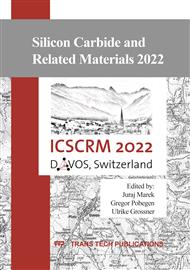p.73
p.81
p.87
p.95
p.103
p.111
p.119
p.125
p.135
Tailoring the Charge Carrier Lifetime Distribution of 10 kV SiC PiN Diodes by Physical Simulations
Abstract:
In this paper, Shockley-Read-Hall (SRH) lifetime depth profiles in the drift layer of 10 kV SiC PiN diodes are calculated after MeV proton implantation. It is assumed that the carbon vacancy will be the domination trap for charge carrier recombination and the SRH lifetime is calculated with defect parameters from the literature and proton-induced defect distributions deduced from SRIM calculations. The lifetime profiles are imported to Sentaurus TCAD and static and dynamic simulations using tailored lifetime profiles are carried out to study the electrical effect of proton implantation parameters. The results are compared to measurements, specializing on optimization of the trade off between on-state and turn-off losses, represented by the forward voltage drop, VT, and reverse recovery charge, Qrr, respectively. Both the simulated and measured IV characteristics show that increasing proton dose, or energy, has the effect on increasing forward voltage drop and on-state losses, while simultaneously, the localized SRH lifetime drop decreases the plasma level, increases the speed of recombination and decreases reverse recovery charge. Finally, TCAD simulations with different combinations of proton energies and fluences are used to optimize the trade-off between static and dynamic performances. Reverse recovery charge and forward voltage drops of these groups of diodes are plotted together, showing that a medium energy which induces the most defects in the depletion region relatively close to the anode gives the best dynamic performances, with a minimum cost of static performance.
Info:
Periodical:
Pages:
119-124
Citation:
Online since:
May 2023
Authors:
Permissions:
Share:
Citation:



